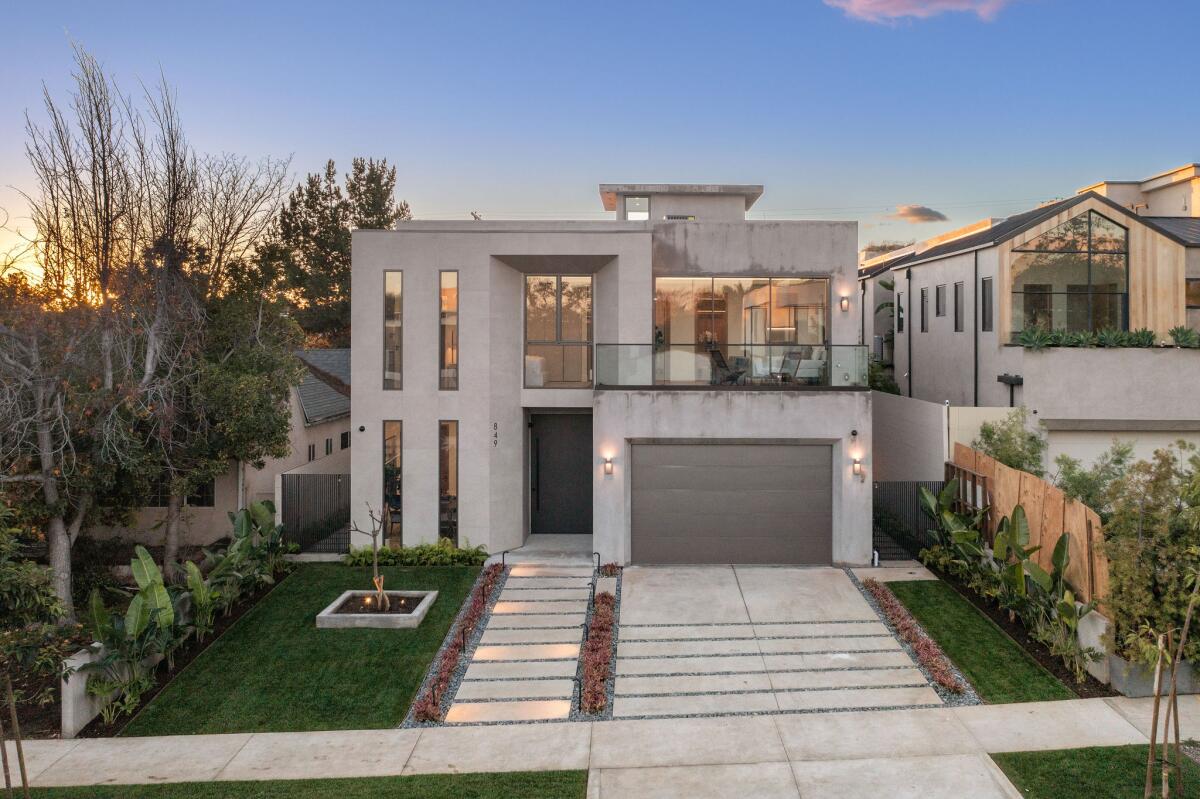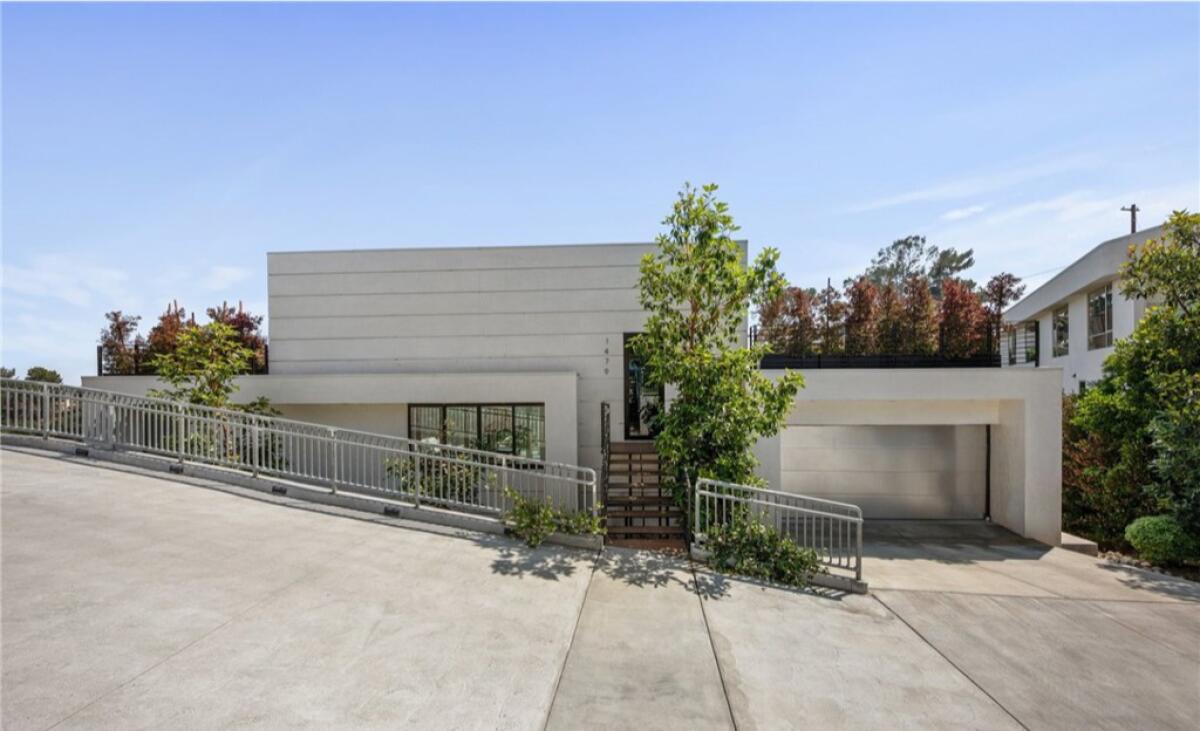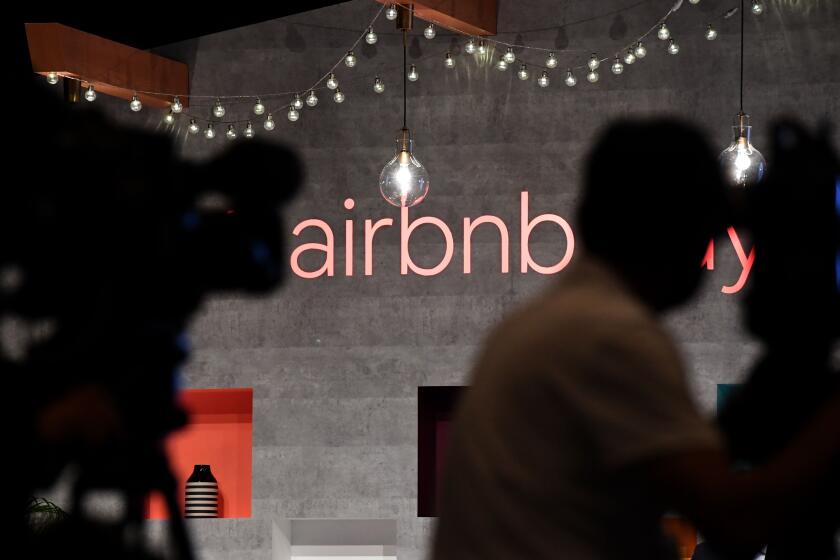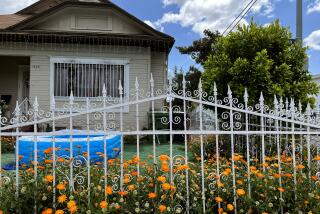L.A. taken over by giant box houses that favor size over style

You’ve seen them. Perhaps they’ve taken over your neighborhood, packing in cheek-by-jowl, straddling hillsides and squeezing out every square inch of space that zoning laws allow.
They are modern box houses, and they’re here to stay — for better or worse.
If architecture serves as a reflection of the world around us, then the surge of box houses over the last 15 years is the natural response to a country dominated by tech, capitalism and an ongoing obsession with ever-larger living spaces.
During the 20th century, Los Angeles home styles were as eclectic as its populace. Wood-shingled Craftsmans mingled with white stucco bungalows. Depending on the neighborhood, you might get an ornate Victorian, chic Midcentury Modern or even a Mayan Revival-style showplace — something that begs you to look at it, admire it. A house that invites an opinion, good or bad.
But although the box houses’ bulk draws attention, its design is basic. They’re like an iPhone: simple and smooth. Clean lines, glass walls, simple shades of white or black. Critics see them as soulless and inert.
Modern homes don’t have time or money for a turret, overhanging eave or stained-glass windows. Sloped ceilings, skylights and other superfluous accents take away from the bottom line — the largest amount of square footage possible for the cheapest possible construction price.
“Box houses are cheaper and faster to build. They’re a hit for buyers seeking space as the ultimate goal,” said real estate agent Bret Parsons. “But when so many are plopped into traditional neighborhoods, it can be jarring to the psyche.”
When such homes started popping up in the wake of the housing crash in 2008, some assumed the trend would be temporary. But demand for the style still rages on today.
In Highland Park, three of the four homes currently on the market built since 2010 are modern. In Hollywood Hills, five of the six homes on the market built since 2010 are modern.
At an October open house for one such listing in Hollywood Hills, potential buyers swarmed despite the relatively cool market.
“I like how open it is,” said Michelle Cook, who’s been shopping around for a modern-style home since the summer. “Having too many rooms stresses me out.”

Cook was open to anything at the beginning of her house hunt, but after a handful of open houses, she decided to go modern or bust. Her checklist: lots of windows, lots of light and lots of space. Modern homes, with their pocketing doors and vast, open rooms, fit the description.
Not everyone is as taken with the style. Over the last decade, critics and home buyers alike have derided modern home design, calling it bland, boring and uninspired.
“Every time I see a new construction and find out it’s gonna be a box, I get sad inside,” said Terry Lee on a morning stroll through Eagle Rock, which has seen a handful of modern homes replace its stock of two- and three-bedroom bungalows in recent years. “This is a pretty neighborhood, and it’s starting to lose its color.”
Charming starter homes haven’t lost their allure, but in the modern market, buyers with deeper pockets clamor for more space — an extra bedroom, bathroom or bonus room. And developers have been building houses bigger and bigger to meet the demand.
Explore the latest prices for homes and rentals in and around Los Angeles.
A 2020 study from StorageCafe found that the average single-family home in L.A. increased in size by 196 square feet from 2010 to 2019. And naturally, building a simple square is the easiest way to maximize square footage while still leaving room for a bit of outdoor space. A two-story, three-story or even four-story box is the most efficient way to squeeze out every allowable inch compared with architectural styles that emphasize style over space.
Over the years, the city has actively stepped in to ensure things don’t get out of hand. L.A. uses tools such as Historic Preservation Overlay Zones and the Baseline Mansionization Ordinance to ensure neighborhoods retain their character and avoid becoming bloated with oversize homes.
In 2017, the city updated the municipal code to regulate the size of certain single-family homes on lots 7,500 square feet or smaller, lowering the maximum floor area from 50% of the lot size to 45%. For example, depending on the zoning designation, a newly built home on a 7,500-square-foot lot can’t be bigger than 3,375 square feet.
Zoning enforcement is serious; when celebrity real estate developer Mohamed Hadid crammed a 30,000-square-foot hillside mega-mansion on a 53,143-square-foot lot in Bel-Air — 56.45% of the lot size — his neighbors sued, and a court ordered it to be torn down. The palatial estate was razed, and the empty lot now sits on the market at $18 million.
Adam Greenfield, a transportation and land-use advocate who has written about the blandness of modern architecture, blames builders, not buyers, for the shift to square houses.
“The market is led by the marketeer. What choices do people have?” he said. “In my neighborhood, if you want to buy a new building, you’ll probably have no choice but to buy a white box.”
Greenfield calls them “milk carton houses,” and said the vast majority of people he talks to prefer traditional architecture styles over modern ones.
“Beauty is in the eye of the beholder, but data shows we are all remarkably similar in how we behold certain things, such as buildings,” he said. “We all walk around with problems, and those problems are exacerbated when we walk through environments that feel emotionally dead instead of ones that make you feel alive.”
As the city tries to crack down on short-term rentals, profits for Airbnb hosts are rising — whether their listings are legal or not.
Greenfield, who shares a 720-square-foot house with his wife, pushes back against the notion that people need, or even want, bigger homes.
“People purchase homes too big for their needs and end up filling rooms with stuff just to make them feel lived in,” he said. “So you get large houses with areas that aren’t clear what you use them for: huge, empty foyers, or rooms you only walk through to get to the next one.”
Some cities have fought to keep their housing stock from becoming too boxy. In 2017, Santa Monica relaxed its stringent downtown city codes after the design community complained it stifled the ability to “do great buildings,” according to Curbed.
The new rules focused on architectural concepts, allowing architects to break up building shapes with varying heights and widths — the opposite of boxes.
Other cities place greater emphasis on architectural variety with design review committees, preservation plans and historic preservation overlay zones, which require new projects to complement the existing style in certain historic neighborhoods. It’s the reason Hancock Park is still flush with English Tudor and French Normandy-style homes, or why Angelino Heights still flaunts rows of well-kept Victorians.
Brent Chang of Compass, who has handled the two priciest home sales in San Marino history, said the city’s design review committee makes it very difficult to build modern box houses. Instead, the city encourages “originality and creativity in the design of new buildings and additions, or the remodeling of existing buildings,” according to the committee’s website.
Chang said younger buyers tend to gravitate toward the modern style, while older buyers who’ve been exposed to more architecture prefer San Marino’s eclectic housing stock.
“My clients buy older, architectural homes because they’re investments. Craftsman homes aren’t cost-effective to build anymore, so as they get older, they get more valuable,” he said. “With modern homes, if your neighbor builds the same thing but newer and with more modern conveniences, your value goes down.”
Bret Parsons sticks to listing homes with an architectural pedigree, such as a Beverly Crest home featured in Architectural Digest that he’s currently marketing for $4.495 million. He believes modern homes have a limited market.
“Any Realtor in the country would rather list a well-designed traditional-style home. They’re just easier to sell,” he said. “They have soul. They were designed with purpose.”
The “bento boxes of today,” as Parsons calls them, are shiny, sleek and sexy, but he said they’ll be tomorrow’s tear-downs.
“They’re all about style over substance. The glass and concrete surfaces aren’t comfortable to live in. The flat roofs get damages by rain after a few years. And if you’re frying fish in the kitchen, you can smell it through the entire house,” he said.
Of course, tastes vary and evolve. Some styles make a comeback; Midcentury Modern homes had lost their allure in the 1980s before they were exalted again by the turn of the century.
Others don’t. Desire for the tract homes of the 1970s and 1980s — big, voluminous clones; the modern boxes of their day — has waned.
Edan Amar, a real estate agent with Keller Williams Hollywood Hills, primarily handles modern box homes. He’s sold more than a dozen over the last year and said they’re a hit because they address people’s current desires and adapt to changing tastes.
“If you’re wondering why these modern homes have become so successful, it’s because they continuously respond to areas in which consumers have become conscious over time,” Amar said.

He offered 1920s Prohibition-era homes as an example; when alcohol was outlawed, high-end home buyers wanted a place to discreetly drink in their homes, so some builders added secret speak-easy rooms and places to hide alcohol.
“The idea that a home should adapt to your lifestyle has not changed,” Amar said. “In today’s world, our lifestyles have shifted to include the ideas of minimalism, physical and mental health awareness and environmental awareness.”
Buyers want minimalism, so modern homes offer minimal room counts with minimal furniture. Buyers emphasize mental health, so modern homes provide a natural blending of indoor and outdoor spaces so residents can get some sun. Buyers want to feel like they’re helping the environment, so modern homes often include eco-conscious flourishes such as solar panels and rain-capture systems.
Amar has a niche business model: he sells tear-downs to spec developers, then sells the finished product once they’re built. The vast majority are modern, and he said he’s sold more than a dozen in the last year.
He added that the design of box houses has slightly shifted over the years as developers try to one-up each other while still staying true to the minimalist style. A 2010 box house might be a simple white square with a few glass windows, while a 2023 box house might offer wood accents, splashes of black for exterior contrast, or a living wall of plants, one of the latest trends for which luxury buyers pine.
He’s currently listing a handful of modern homes, including a brand new box-style house in Hollywood for $2.9 million. To set itself apart from other modern builds, the home features a sleek black garage and angled rooflines, a departure from the traditional flat squares normally featured.
The modern style has made its way into nearly every L.A. neighborhood where new homes are being built, but sometimes for different reasons. Hollywood Hills is chock-full of modern homes because the walls of windows are great for taking in hillside views. Others pop up in trendy neighborhoods such as Silver Lake or Glassell Park as developers try to meet the demands of young, hip people moving there.
Sometimes, the style can become a self-fulfilling prophecy in which one modern house can lead to several others being built around it.
For example, developer Avo Atnalian recently built a modern home in Highland Park because the houses around it were modern.
“When I’m building a home, I don’t want to build out of character of the neighborhood around it,” he said. “There were several similar houses in the area, so I decided to go with a modern look so it can blend in.”
Listed for $2.498 million, the hillside home spans three stories and slightly more than 3,000 square feet. Atnalian originally built it for himself but then decided to sell, hoping to attract a young person or family moving to the area.
He said the style is timeless and expects the value to go up in the future, similar to how Midcenturies and Craftsmans have attracted younger generations decades after they were built.
“This will be in demand indefinitely,” he said. “The style is here to stay.”
More to Read
Sign up for This Evening's Big Stories
Catch up on the day with the 7 biggest L.A. Times stories in your inbox every weekday evening.
You may occasionally receive promotional content from the Los Angeles Times.












